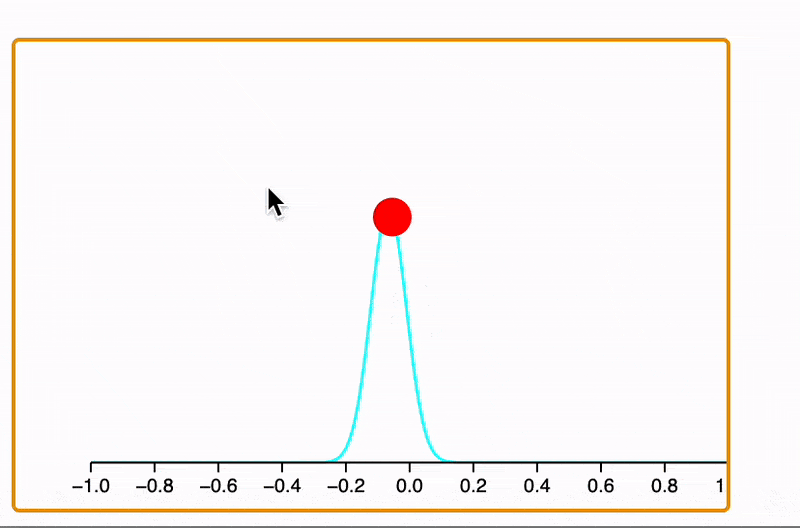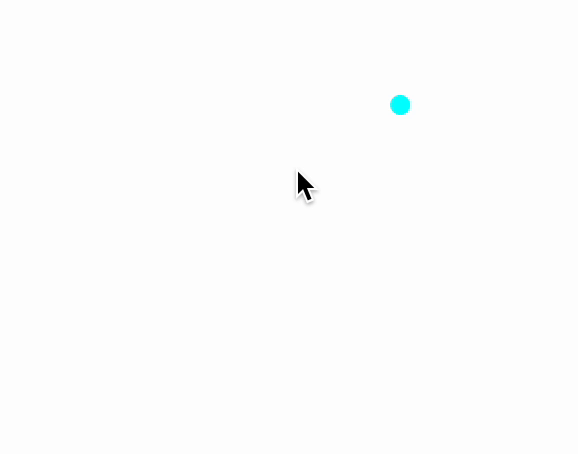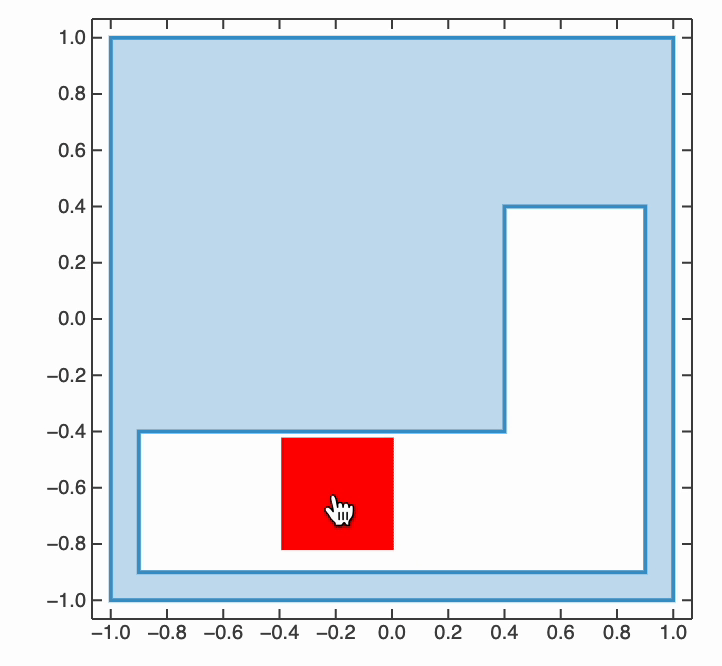Mouse and keyboard
In this section, we discuss how a user can interact with dynamic elements, providing different types of input.
UI Elements
A core package, wljs-inputs, provides a set of basic UI elements used for creating buttons, sliders, text fields, and more.
If you need a custom element, you can create it directly in the notebook using WLX or JavaScript cell types. Please see the guide: Emitting events.
The following elements are available out of the box:
And for grouping elements:
Examples
Each standard input element is an EventObject, to which you can assign any handler function. You don't necessarily need to assign it to a variable. For example (see InputButton):
EventHandler[InputButton["Click"], Beep]
is equally valid as:
btn = InputButton["Click"];
EventHandler[btn, Beep];
btn
Here are some other examples:
EventHandler[InputRange[0, 1, 0.1], Function[value, radius = value]]
% // EventFire; (* just to initialize `radius` *)
Graphics[{LightBlue, Disk[], Pink, Disk[{0,0}, radius // Offload]}]
Apply EventFire to any EventObject to manually fire an event with a default value to initialize your variables, if needed.
You can also add a label to an InputRange:
InputRange[0, 1, 0.1, "Label" -> "Radius"]
And an initial value as the fourth argument:
InputRange[0, 1, 0.1, 0.7, "Label" -> "Radius"]
Here is an example using InputSelect:
angle = 45 Degree;
EventHandler[InputSelect[{Pi/2 -> "90", Pi/4 -> "45", 0 -> "0"}, Pi/4], Function[value, angle = value]]
Graphics[{Rotate[Rectangle[{0,0}, {1,1}], angle // Offload]}]
Here is a simple text input:
text = "Example";
EventHandler[InputText[], Function[value, text = value]]
Graphics[Table[{
Hue[i/10., 1., 1.], Rotate[Text[Style[text // Offload, FontSize -> RandomInteger[{12, 24}]], RandomReal[{-1,1}, 2]], RandomChoice[{Pi, Pi/4, Pi/2, 0}]]
}, {i, 10}]]
Grouping Input Elements
If you only need visual grouping, consider using Grid, Row, or Column, e.g.:
slider = InputRange[0, 1, 0.1];
button = InputButton[];
{slider, button} // Column
Another way to group at the event level is using InputGroup:
slider = InputRange[0, 1, 0.1];
button = InputButton[];
joined = InputGroup[<|"Button" -> button, "Slider" -> slider|>, "Label" -> "Group"];
EventHandler[joined, Print]
It merges an association (as above) or a list of EventObjects into a new one. You do not need to assign separate EventHandlers—just one joined handler is enough. It fires an event preserving the original structure of the association or list:
<|"Slider" -> 0.5, "Button" -> True|>
Joining Different Events
You can also merge event objects underlying UI elements using Join. Here’s a simple example:
button = InputButton[]
slider = InputRange[0, 1, 0.1]
EventHandler[Join[button, slider], Function[data,
Print[data]
]];
You’ll get either:
True
Or:
0.5
Depending on which element triggered the event. To distinguish them, use topics (see EventObject):
button = InputButton["Topic" -> "Button"]
slider = InputRange[0, 1, 0.1, "Topic" -> "Slider"]
EventHandler[Join[button, slider], {type_ :> Function[data,
Print[type <> ":" <> ToString[data]]
]}];
Or capture them individually:
button = InputButton["Topic" -> "Button"]
slider = InputRange[0, 1, 0.1, "Topic" -> "Slider"]
EventHandler[Join[button, slider], {
"Button" -> Beep,
"Slider" -> Print
}];
The slider prints a message; the button triggers a beep.
Chaining Events
Most GUI elements support chaining, where each reuses the same EventObject. It’s passed as the first argument:
ev = EventObject[];
InputButton[ev, "Topic" -> "Button"]
InputRange[ev, 0, 1, 0.1, "Topic" -> "Slider"]
EventHandler[ev, {
"Button" -> Beep,
"Slider" -> Print
}];
With this approach, there's no need to create and join new events. This leaves a smaller footprint and reduces overhead.
2D Graphics
Some primitives, as well as the entire canvas, support the EventHandler method. Let's start with Graphics itself.
Graphics as an Event Generator
You can attach event handlers to a Graphics expression, which represents the SVG container of your 2D graph.
This approach offers some benefits over using Primitives. For instance, events like "mousemove" or "click" are captured even if other objects are layered on top. The following event patterns (or topics for EventHandler) are supported:
"keydown": Captures keyboard input after the canvas is clicked"capturekeydown": Same as above but also prevents page scrolling"mousemove": Captures mouse movement"mouseup": Captures mouse up"mousedown": Captures mouse down"click": Captures clicks (without the Alt key)"altclick": Captures clicks with the Alt key held"onload": Fired once a canvas loaded
Example:
pt = {};
EventHandler[
Graphics[{
PointSize[0.05], Blue, Opacity[0.5],
Point[pt // Offload]
}, PlotRange -> {{-1, 1}, {-1, 1}}],
{"mousemove" -> Function[xy, pt = Append[pt, xy]]}
]
One can do the same with Plot, since it produces Graphics symbol.
Alternative Way
An alternative approach to assigning handlers:
pt = {};
Graphics[{
PointSize[0.05], Blue, Opacity[0.5],
Point[pt // Offload],
EventHandler[Null, {"mousemove" -> Function[xy, pt = Append[pt, xy]]}]
}, PlotRange -> {{-1, 1}, {-1, 1}}]
When EventHandler has Null as its argument, it attaches to the nearest parent. Similarly, you can attach handlers using Epilog or Prolog.
Primitives
Certain graphic primitives also support EventHandler. Supported primitives include:
They support these patterns:
"drag": Makes the primitive draggable and returns coordinates"dragsignal": Makes the primitive to capture dragging, but does not drag the primitive itself. Returns coordinates"dragall": Like"drag", but also fires events at drag start and end"click": Captures clicks without the Alt key"altclick": Captures clicks with the Alt key"mousedown": Fires on mouse press"mouseup": Fires on mouse release"mousemove": Captures movement"mouseover": Captures entry into element area"zoom": Captures mouse wheel input
For example, combining "zoom" and "drag", you can manually fit Gaussian curves:
Try moving your mouse wheel on the red dot and then drag it.

You can also create a basic mouse follower using a white rectangle with a "mousemove" pattern:
pt = {0, 0};
Graphics[{
White,
EventHandler[
Rectangle[{-2, -2}, {2, 2}],
{"mousemove" -> Function[xy, pt = xy]}
],
PointSize[0.05], Cyan,
Point[pt // Offload]
}]
a mouse follower

Here is another example, where we make an object draggable, but update it manually. In general it allows us to apply additional constraints:
outer = RegionDifference[
Rectangle[{-1,-1}, {1,1}],
RegionUnion[
Rectangle[{-0.9,-0.9}, {0.9,-0.4}] ,
Rectangle[{0.4,-0.9}, {0.9,0.4}]
]
];
outer = Rationalize[outer, 0]; (* WL14 bug *)
RegionPlot[outer];
distanceOp = RegionDistance[outer, Translate[Rectangle[-{0.2,0.2}, {0.2,0.2}], #]]&;
rect = {0.65, 0.15};
RegionPlot[outer, Epilog->{
Red,
Translate[EventHandler[
Rectangle[-{0.2,0.2}, {0.2,0.2}],
{"dragsignal" -> Function[target,
If[distanceOp[target] > 0, rect = target]
]}
], Offload[rect]]
}]

Image
You can attach event handlers to a Image expression similar to the previous one.
The following event patterns (or topics for EventHandler) are supported:
"mousemove": Captures mouse movement"mouseup": Captures mouse up"mousedown": Captures mouse down"click": Captures clicks (without the Alt key)"altclick": Captures clicks with the Alt key held
EventHandler[Image[...], {
"click" -> Print
}]
3D Graphics
Currently, event listeners in Graphics3D are limited.
Primitives
The following 3D primitives support EventHandler methods:
They support:
"transform": Makes the object draggable and sends an association with a"position"field"drag": a simplified version oftransformthat only sends the coordinates
This is especially useful for dynamic lighting systems. For example:
point = {1, 1, 1};
Graphics3D[{
Shadows[True],
Polygon[{{-5, 5, -1}, {5, 5, -1}, {5, -5, -1}, {-5, -5, -1}}],
White,
Cuboid[{-1, -1, -1}, {1, 1, 1}],
Shadows[False],
PointLight[Red, {1.5075, 4.1557, 2.6129}, "Intensity"->100],
Shadows[True],
SpotLight[Cyan, point // Offload],
EventHandler[Sphere[point, 0.1], {
"transform" -> Function[assoc, point = assoc["position"]]
}]
}, "Lighting" -> None]
